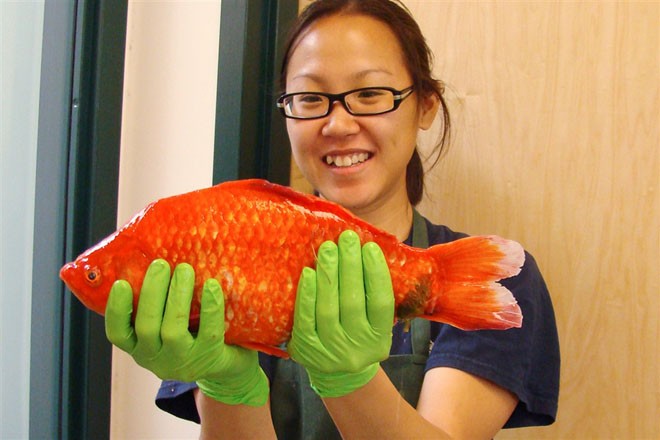Gargantuan goldfish infestation in Lake Tahoe
by Alan McStravick on 6 Mar 2013

Christine Ngai, a researcher at the University of Nevada, Reno, holds a giant goldfish pulled from Lake Tahoe. The monstrous creatures are just one of several aquatic invasive species that have colonized the lake for years, scientists say. Heather Segale / University of Nevada, Reno
If you’ve paid any attention whatsoever to the latest news, you have no doubt heard of exotic animals being released back into the wild. One such situation is the invasion in the Everglades of the Burmese Python. Exotic animal enthusiasts, not fully comprehending the necessary care or the full adult size of these animals, have released their creatures into the wild.
Another example of this was also realized in the waters of Lake Tahoe this week. Giant goldfish, some growing to a length of 18 inches, have infested the waters of Lake Tahoe and are threatening the delicate ecosystem of the lake.
It is widely believed these large fish, not a native species to the lake, were dumped into the lake by their previous owners.
Much like the pythons of the Everglades, this non-native species seems to be thriving in this freshwater lake environment. They have taken to an escalated breeding scale, increasing their numbers to a point that experts believe could adversely impact Lake Tahoe’s ecosystem.
'We know that we have a giant goldfish, the question now becomes how long has it been there and how many others are there in the lake?' Dr Sudeep Chandra, an associate professor at the University of Nevada, Reno (UNR), told Sacramento NBC affiliate station KCRA.
Also of UNR, Christine Ngai, a member of the crew that discovered the giant goldfish, said even though she had heard of these creatures, it wasn’t until she actually saw one that she was able to register just what a mesmerizing experience it was.
'It’s not your average-size goldfish. So, you’re like, is that real? Oh, it’s real,' she told KCRA.
Ngai, along with other researchers from UNR, University of California, Davis (UC Davis), and the California Department of Fish and Game, utilize a specialized boat that temporarily stuns nearby fish in their regular surveys of the lake. Once the electric probes stun the fish, the research team is able to scoop the fish up with a net for the purpose of counting and examining them. Ngai, in her interview with KCRA, commented, 'You can get 200 fish in one scoop.'
While the giant goldfish is now on the radar of these researchers, they are still far more concerned with the proliferation of large-mouth bass in Lake Tahoe. This is because the bass outnumber the goldfish 100 to one. However, in pointing out the steep increase in the number of giant goldfish, the team explains how easy it is for an invasive species to take hold.
Aquarium dumping, a widespread problem both in the US and around the world, may not be the only culprit for this explosion of the goldfish population. A comment thread on the Huffington Post pointed out how goldfish are often used as a cheap bait fish for bass fishermen. These goldfish, either by wriggling off of the hook or being dumped from the bait buckets at the end of the day, could have been introduced in a few different manners.
According to the UC Davis report on California’s aquarium trade, numerous aquarium species are dumped in to the wild every year.
Sue Williams, professor of ecology at UC Davis and lead author of the report, stated, 'Globally, the aquarium trade has contributed a third of the world’s worst aquatic and invasive species.'
Another report, from 2006, stated while pet fish, mollusks and other species have the ability to wreak havoc on our domestic water bodies, it is the goldfish that is the animal 'most frequently released and can do some of the worst damage to native species.'
Pamela Schofield, an ecologist at the US Geological Survey, said, 'Oftentimes people think, ‘Well, gee, if I just dumped in one fish, that’s not going to make a difference.’ But it can with the goldfish because of the way they eat – they root around in the sediment and that suspends the sediment up in the water.' This act of rooting in the sediment can lead to murky water, destroyed vegetation and water turbidity.
Experts agree further outreach must be done to address aquarium owners’ need to be responsible when they no longer want their live fish and other aquarium species. Williams even goes so far as to say that killing the animals would be far better than dumping them into the
Read the Full Story here
If you want to link to this article then please use this URL: www.sail-world.com/107192